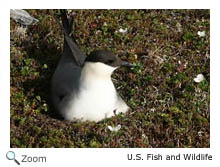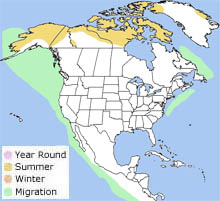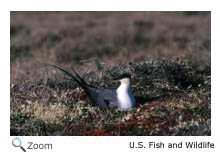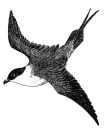Description
 The long-tailed jaeger is 18-21
inches in length. It has a slightly hooked bill, webbed feet, and 6-10 inch
long pointed center tail feathers that stick out beyond its other tail feathers. During the non-breeding season, it looses its center tail feathers. In the breeding season, it has a gray back and wings, a white head and belly, and a dark brown cap on its head. In the non-breeding season, its cap has white and gray spots on it, and its undersides have light brown and white bars. Males and females look alike. The long-tailed jaeger is 18-21
inches in length. It has a slightly hooked bill, webbed feet, and 6-10 inch
long pointed center tail feathers that stick out beyond its other tail feathers. During the non-breeding season, it looses its center tail feathers. In the breeding season, it has a gray back and wings, a white head and belly, and a dark brown cap on its head. In the non-breeding season, its cap has white and gray spots on it, and its undersides have light brown and white bars. Males and females look alike.
Range  The long-tailed jaeger is found in northern Alaska and northern Canada during the breeding season. During migration, it is found
on shores and estuaries.
It winters
on offshore waters on the Atlantic and Pacific Oceans. The long-tailed jaeger is found in northern Alaska and northern Canada during the breeding season. During migration, it is found
on shores and estuaries.
It winters
on offshore waters on the Atlantic and Pacific Oceans.
Habitat
The long-tailed jaeger breeds on the tundra and coastal marshes in the Arctic. In the winter, it usually is found on the open ocean, far from the shoreline
|
|
Diet
 The long-tailed jaeger eats
fish, crustaceans, insects, and small birds. It also eats small mammals like lemmings and voles. It hovers over its land prey, circling like a hawk. It then swoops down and snatches up the prey! It catches insects in the air and it steals food from other seabirds but not as often as the
Parasitic Jaeger. The long-tailed jaeger eats
fish, crustaceans, insects, and small birds. It also eats small mammals like lemmings and voles. It hovers over its land prey, circling like a hawk. It then swoops down and snatches up the prey! It catches insects in the air and it steals food from other seabirds but not as often as the
Parasitic Jaeger.
Life Cycle
 Male and female pairs make a nest in a shallow depression on the ground. The female lays 1-2 eggs. Both the male and the female incubate the eggs. The female usually spends more time on the nest. The chicks leave the nest a few days after hatching. One parent stays with the chicks while the other parent brings food back to the nest. The adult regurgitates food for the chicks to eat. The chicks fledge when they are 21-27 days old, but their parents stay with them for a few more weeks. Male and female pairs make a nest in a shallow depression on the ground. The female lays 1-2 eggs. Both the male and the female incubate the eggs. The female usually spends more time on the nest. The chicks leave the nest a few days after hatching. One parent stays with the chicks while the other parent brings food back to the nest. The adult regurgitates food for the chicks to eat. The chicks fledge when they are 21-27 days old, but their parents stay with them for a few more weeks.
Behavior The long-tailed jaeger is the smallest species of jaeger.
|



 The long-tailed jaeger is found in northern Alaska and northern Canada during the breeding season. During migration, it is found
on shores and
The long-tailed jaeger is found in northern Alaska and northern Canada during the breeding season. During migration, it is found
on shores and 
